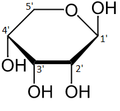Ribose
Ribose is a carbohydrate that plays a crucial role in the formation of RNA, DNA, and ATP. It is a monosaccharide with the chemical formula C5H10O5. Ribose is a key component of several important biomolecules, including nucleic acids and nucleotides.
Structure[edit]
Ribose is a pentose sugar, meaning it has five carbon atoms. It has a linear form and a ring form, with the ring form being more stable and therefore more common. The ring form of ribose is a furanose, a five-membered ring with four carbon atoms and one oxygen atom.
Biological role[edit]
Ribose is a critical component of several important biomolecules. It forms the backbone of RNA, where it links together nucleotides to form the RNA strand. In DNA, a related sugar called deoxyribose performs a similar function. Ribose is also a component of ATP, the main energy currency of the cell, as well as other important biomolecules like coenzyme A, NADH, and FAD.
Synthesis[edit]
In cells, ribose is synthesized from glucose through the pentose phosphate pathway. This pathway also produces NADPH, a molecule important for redox reactions in the cell.
Clinical significance[edit]
Because of its role in energy production, ribose has been studied as a potential treatment for conditions like chronic fatigue syndrome and fibromyalgia. However, the evidence for its effectiveness is mixed, and more research is needed.
See also[edit]
|
|
|
Ribose[edit]
-
Fischer Projection of L-Ribose
-
Beta-D-Ribofuranose
-
D-рибоза
-
L-рибоза
-
Alpha-D-Ribopyranose
-
Alpha-D-Ribopyranose numbered
-
Beta-D-Ribopyranose numbered
-
Alpha-D-Ribofuranose numbered
-
Beta-D-Ribofuranose Numbered
-
2' endo
-
2' endo 3' exo
-
3' endo 2' exo
Ad. Transform your life with W8MD's Budget GLP-1 injections from $75


W8MD offers a medical weight loss program to lose weight in Philadelphia. Our physician-supervised medical weight loss provides:
- Weight loss injections in NYC (generic and brand names):
- Zepbound / Mounjaro, Wegovy / Ozempic, Saxenda
- Most insurances accepted or discounted self-pay rates. We will obtain insurance prior authorizations if needed.
- Generic GLP1 weight loss injections from $75 for the starting dose.
- Also offer prescription weight loss medications including Phentermine, Qsymia, Diethylpropion, Contrave etc.
NYC weight loss doctor appointmentsNYC weight loss doctor appointments
Start your NYC weight loss journey today at our NYC medical weight loss and Philadelphia medical weight loss clinics.
- Call 718-946-5500 to lose weight in NYC or for medical weight loss in Philadelphia 215-676-2334.
- Tags:NYC medical weight loss, Philadelphia lose weight Zepbound NYC, Budget GLP1 weight loss injections, Wegovy Philadelphia, Wegovy NYC, Philadelphia medical weight loss, Brookly weight loss and Wegovy NYC
|
WikiMD's Wellness Encyclopedia |
| Let Food Be Thy Medicine Medicine Thy Food - Hippocrates |
Medical Disclaimer: WikiMD is not a substitute for professional medical advice. The information on WikiMD is provided as an information resource only, may be incorrect, outdated or misleading, and is not to be used or relied on for any diagnostic or treatment purposes. Please consult your health care provider before making any healthcare decisions or for guidance about a specific medical condition. WikiMD expressly disclaims responsibility, and shall have no liability, for any damages, loss, injury, or liability whatsoever suffered as a result of your reliance on the information contained in this site. By visiting this site you agree to the foregoing terms and conditions, which may from time to time be changed or supplemented by WikiMD. If you do not agree to the foregoing terms and conditions, you should not enter or use this site. See full disclaimer.
Credits:Most images are courtesy of Wikimedia commons, and templates, categories Wikipedia, licensed under CC BY SA or similar.
Translate this page: - East Asian
中文,
日本,
한국어,
South Asian
हिन्दी,
தமிழ்,
తెలుగు,
Urdu,
ಕನ್ನಡ,
Southeast Asian
Indonesian,
Vietnamese,
Thai,
မြန်မာဘာသာ,
বাংলা
European
español,
Deutsch,
français,
Greek,
português do Brasil,
polski,
română,
русский,
Nederlands,
norsk,
svenska,
suomi,
Italian
Middle Eastern & African
عربى,
Turkish,
Persian,
Hebrew,
Afrikaans,
isiZulu,
Kiswahili,
Other
Bulgarian,
Hungarian,
Czech,
Swedish,
മലയാളം,
मराठी,
ਪੰਜਾਬੀ,
ગુજરાતી,
Portuguese,
Ukrainian















